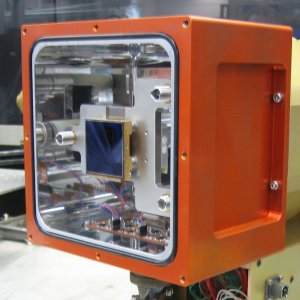 CAPSCam
is the Carnegie Astrometric Planet Search Camera. It uses a
2048 × 2048 pixel HyViSi detector from Teledyne,
based on the HAWAII-2RG multiplexer with Si as the photosensitive
material.
CAPSCam
is the Carnegie Astrometric Planet Search Camera. It uses a
2048 × 2048 pixel HyViSi detector from Teledyne,
based on the HAWAII-2RG multiplexer with Si as the photosensitive
material.The detector is mounted in our standard single-chip rectangular aluminum housing, coupled to an IR-Labs ND-2 cryostat. The control electronics box is mounted to the side of the dewar (see photos below). The system is liquid nitrogen cooled, and has a hold time of approximately 13 hours.
The CAPSCam window serves as the system passband filter, with a wavelength range of 800 to 930 nm. The filter is made with a multilayer coating on a 90 mm diameter fused-silica window from Barr Associates.
The detector controller is a compact, 4-channel digital signal processor based system. It is a modified version of our BASE ccd control electronics.
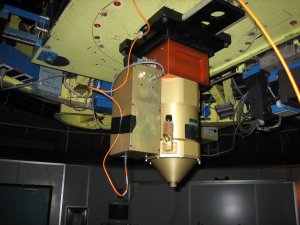 CAPSCam on DuPont 100" telescope |
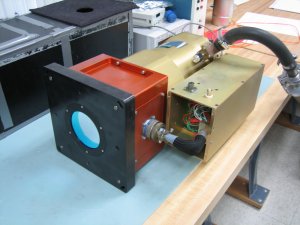 CAPSCam on pump in lab |
CAPSCam Science
A Jupiter-mass planet on a Jupiter-like orbit around a solar-type star produces an astrometric wobble of the primary star of 2 milliarcsec (peak to peak) when viewed from a distance of 5pc.
Thus an astrometric accuracy of ±0.250 milliarcsec would allow the detection of such a planetary companion with a signal-to-noise ratio of 4. For lower mass stars, the nominal astrometric detection limit drops to proportionately lower planet masses.
The key to this program is achieving and maintaining an astrometric accuracy of better than 0.25 milliarcseconds for a decade or longer. CAPSCam is designed to take advantage of the superior seeing and astrometric stability of the duPont telescope at Las Campanas
Observatory.
The Rockwell array permits the definition of an arbitrary guide window that can be read out (and reset) rapidly and independently of the rest of the array. The guide window will be centered on our nearby, relatively bright target stars, with short exposure times. The rest of the array will integrate for prolonged periods on the background reference grid of fainter stars without saturating the target stars.
HyViSi Detector Properties
The HyViSi / HAWAII-2RG is a three-side buttable, silicon-based hybrid focal plane array, with Si PIN photodiodes indium-bump-bonded to a CMOS readout multiplexer. The active, light-sensitive area of the array is 2040 × 2040 active pixels, surrounded on each side (window frame style) by 4 rows and columns of reference pixels for a total of 2048 × 2048 elements. This SPIE paper describes some of the properties of the detector.
In our configuration, the detector operates with four output channels at 125 kHz. Each channel is a 2408×512 stripe of the array. The detector also has a guide window mode, with programmable size and location. This mode allows a selected subarray to be read, without disturbing the main array. A few simple clock signals and a serial interface are used to select and control the various detector array operations.
Use of the guide window is the essential feature of CAPSCam. For astrometry, the bright, nearby target stars can be read (and reset) multiple times with short exposure times in the guide window, while the fainter background reference stars accumulate more signal with longer exposure times.
The H2RG array nominally includes two temperature sensors, which are disabled for the HyViSi chip to allow a detector substrate voltage to be added.
 Top View (on handling fixture) |
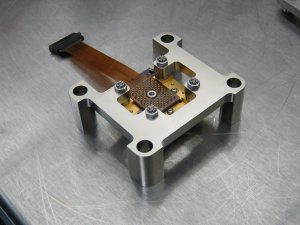 Bottom View (on handling fixture) |
Signals from the detector are carried by a flex-cable, with a 65-pin nanonics connector at the end. This plugs directly into a mating connector (STM065L84N) on the preamp board.
 H2RG Package drawing |
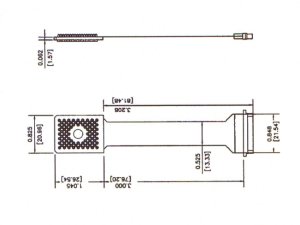 H2RG Flex cable pinout |
Dewar Mechanical Internals
The HyViSi detector is mounted on an invar-36 plate, which has been ground flat. The plate is mounted on top of three fiberglass (G10) posts. The mounting points are threaded so that the position and flatness of detector assembly with respect to the faceplate can be adjusted.
On the back of the platten, there are two temperature sensors and two heater resistors (for redundancy). There is a thin sheet of mica where the cold post from the dewar makes contact to provide electrical isolation.
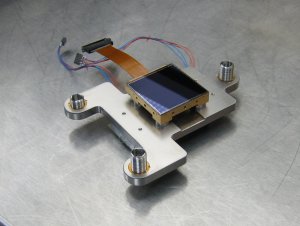 Detector on Invar platen |
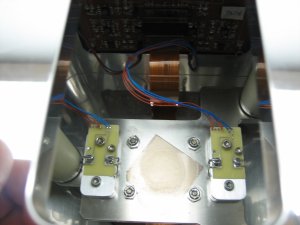 Back of invar platen |
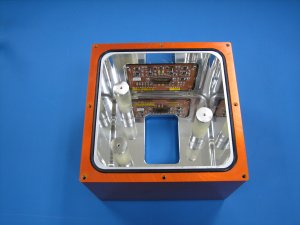 Top View -- Detector Housing |
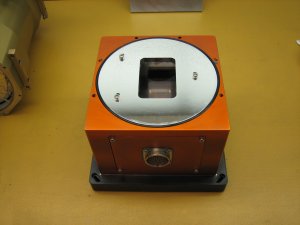 Bottom View -- Detector Housing |
Inside the housing, there is a rigid-flex preamp board mounted onto a sidewall plate. The preamp pcb signals are brought out via a 79-pin hermetic connector.
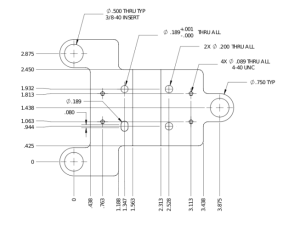 Platen drawing |
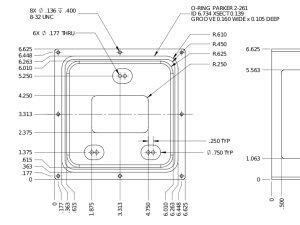 Cube drawing |
Signal Processing Electronics
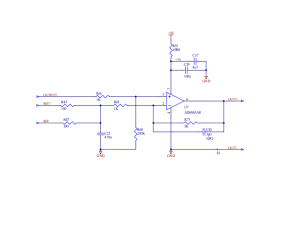 Preamp schematic |
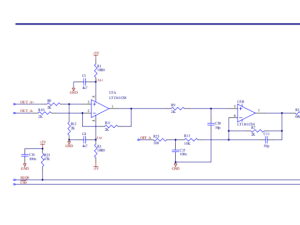 Signal processing schematic |
The preamp is a simple, dc-coupled amplifier with an offset/reference input. Each signal processing channel consists of a buffer op-amp, a filter op-amp stage with offset, and a 16-bit analog-to-digital converter.
Software
The control software is written in assembly language to run on the DSP56303 processor in the system. It controls the sequence of events for the detector [reset, read, expose and read] and the shutter to produce a useful astrometric exposure. The complete sequence for the three modes of operation (FF, GW, FF+GW) is here.
Test Results and Known Issues
 H2RG readout sequence |
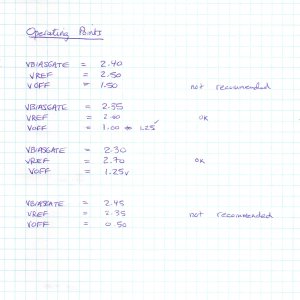 Operating voltages |
Capscam operates at a temperature of -150 deg C, using the slow, buffered output mode. The operating point(s) are given in the above table. Some oscilloscope traces of the various clocking signals are available here.
Ian Thompson (ian@obs.carnegiescience.edu)